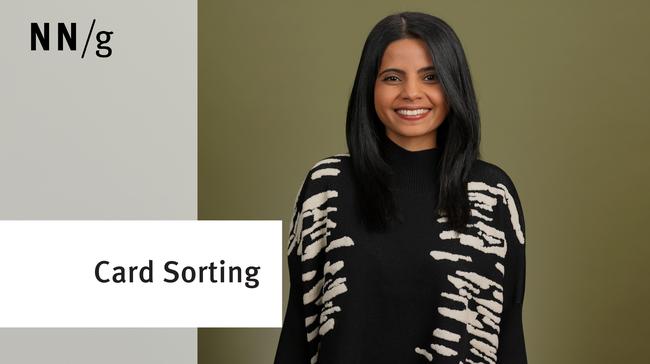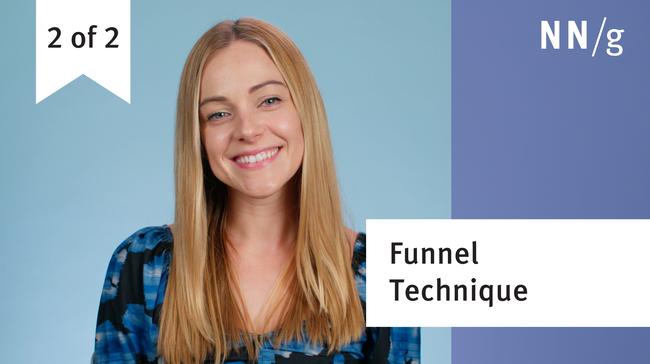A user interview is a popular UX research method often used in the discovery phase.
User interview: A research method where the interviewer asks participants questions about a topic, listens to their responses, and follows up with further questions to learn more.
The term “user interview” is unique to the UX field. In other areas, like market research or social science, the same method is called an in-depth interview, a semi-structured interview, or a qualitative interview.
Why Conduct User Interviews?
When performed well, user interviews provide in-depth insight into who your users are, their lives, experiences, and challenges. Learning these things helps teams identify solutions to make users’ lives easier. As a result, user interviews are an excellent tool to use in discovery.
Here are some of the many things you can learn by interviewing your users:
- What users’ experiences were like, what was memorable, and why
- Users’ pain points during an experience
- How users think or feel about a topic, event, or experience
- What users care about
- Users’ mental models
- Users’ motivations, aspirations, and desires
User interviews help teams build empathy for their users. When teams watch interviews, they can put themselves in their users’ shoes.
Data gathered from user interviews can be used to construct various UX artifacts, including
Interviews are versatile; they can be used to learn about human experiences or about a customer's experience with one of your existing products. For example, imagine you are working on an app used to track calorie intake. You could interview people about their experiences using the app or about their journey to become healthier (or both).
User Interviews vs. Usability Tests
User Interviews are often confused with usability tests. While they sound similar and are both typically one on one, these two methods are very different and should be used for different purposes.
| User Interview | Usability Test | |
|---|---|---|
| Purpose | To generate new knowledge about your users, their experiences, needs, and pain points | To assess a design: how it performs, what’s not working, and why |
| Research type | Attitudinal: we collect participants’ reported behaviors, thoughts, and feelings |
Behavioral: we directly observe how users interact with a design |
| When used | Empathize stage of the design-thinking model (or in discovery) | Test stage of the design-thinking model (or when a team is working on a product in alpha or beta) |
| Design | Absent: participants don’t review or try a design | Present: participants interact with a design |
| Facilitator–participant interaction | More natural interaction: regular eye contact, facilitators are warmer and approachable | More rigid interaction: Sporadic eye contact; facilitators avoid being too friendly |


How to Do a User Interview
1. Identify What You’d Like to Learn
Think of an interview as a research study, not a sales session or an informal conversation. Like any research study, an interview should have research goals (or research questions). Goals that are too broad (like learning about users) can result in interviews that fail to produce useful or actionable insights. Examples of reasonable research goals include:
- What causes customers to consider and try our product?
- What are the highs and lows of their experience?
- How much knowledge of the process do users have?
- What makes users abandon the product?
A concise, concrete set of goals that relate to your target users’ specific behaviors or attitudes can help you gather helpful and actionable insights. These goals will influence the questions you’ll ask in your interviews.
2. Prepare a Guide
An interview guide is used to direct the conversation and help you answer your research goals. An interview guide should contain a few well-designed, open-ended questions that get participants talking and sharing their experiences.
Examples of good open-ended questions include:
- Walk me through a typical day for you.
- Tell me about the last time you [did something].
- Tell me about a time when you [had a particular experience].
Jog the memory by asking about specific events rather than about general processes. Remembering a particular incident will nudge the user’s memory and enable them to give you meaningful details.
An interview will also contain followup questions to gather more-detailed information. When constructing the guide, these questions are often nested underneath the main questions. Construct followup questions based on your research goals. Anticipating different responses can help you identify what followup questions to ask. Examples include:
- When did this happen?
- How long did it take you?
- Has this happened to you before?
- How did you feel during this experience?
An interview guide can be used flexibly: interviewers don’t need to move through questions linearly. They can skip questions, spend longer on some questions, or ask questions not in the guide. (See our interview-guide article for an example guide.)
3. Pilot Your Guide
Even the best guide may need to be tweaked after the first interview. Piloting allows you to identify what tweaks are needed before running all your interviews. You can pilot your guide with a friend or colleague if the interview topic isn’t too specialized. Or, you can recruit a target user (or two).
Piloting helps you learn:
- Whether any questions were misunderstood or caused confusion
- If there are questions that should be added to the guide
- If any questions should be removed because they aren’t likely to provide helpful information
- Whether the order of the questions felt natural
Since interviews are a qualitative research method, it’s okay to continue making minor tweaks to your guide as you complete all your interviews. However, avoid changing your research goals throughout the study. It may become difficult to achieve your research goals without collecting enough relevant data.
4. Start Easy
Some participants can feel nervous at the beginning of the interview, especially if they’re not sure what to expect. Start by talking through the purpose of the interview, what kinds of questions will be asked, and how the information will be used. Slow down your pace of speech. Talking slowly has a calming effect and indicates that you are not anxious and have time to listen.
Start with questions that are easy to answer, such as Tell me a bit about yourself or What do you like to do in your spare time? These questions are easy to answer and can get participants comfortable talking. Avoid asking questions likely to be interpreted as personal or judgmental, such as What was the last book you read? This question assumes the user read a book recently; if they didn’t, they might feel stupid.
5. Build Rapport
People are more likely to remember, talk, and let their guard down if they feel relaxed and trust the interviewer and the process. Keep in mind that there’s a big difference between rapport and friendship. The user does not have to like you, think you’re funny, or want to invite you out for a cup of coffee in order to trust you enough to be interviewed.
Build rapport by showing you’re listening and by asking related questions. You can show you’re listening by using verbal and nonverbal cues. Verbal cues include:
- Neutral acknowledging like, I understand, okay, I see
- Making noises like mmmh
- Echoing what the participant has said
- Adjusting the speed, volume, and intonation of your questions
Nonverbal cues include:
- Frequent eye contact
- Nodding
- Raising eyebrows occasionally
- Smiling when the participant smiles (also known as mirroring)

Avoid interrupting or rushing participants as these behaviors will harm your ability to build rapport.
6. Follow Up and Probe
Ask your prepared followup questions if the participant did not cover them when sharing their experiences. Additionally, ask further questions that probe into your participant’s responses. These questions help you to uncover those important motivations, mental models, perceptions, and attitudes.
Probing questions include:
- Tell me more about that.
- Can you expand on that?
- What do you think about that?
- How do you feel about that?
- Why is that important to you?
Since you won’t know when you might use them, probing questions are not usually prepared in advance. However, if you know you might forget to use them, write them at the top of your guide or on an index card.

Can Interviews be Used with Other Methods?
Yes. You can mix interviews with other methods, such as:
- With a usability test. You might want to learn about the participant before giving them tasks on a design. Your session might begin with a short interview before transitioning to the test. When user tests and interviews are combined, sessions are usually longer (for example, 90 minutes rather than 60 minutes). If you’re combining these methods, the questions you ask in the interview shouldn’t prime users to pay more attention to certain things in the design.
- With a field study or some kind of observational study. You could perform an interview before or after observing a study participant work on their tasks. An interview before an observational study can give you context into what you will observe. An interview after a field study allows you to follow up on interesting things you observed.
- With a diary study. In longer diary studies, it may be beneficial to have an initial interview before the logging period to learn about the participant and prepare them for the diary study. After the logging period ends, a wrapup interview is often conducted to learn more about the participant’s diary entries.
Limitations of Interviews
Since interviews are an attitudinal method, they collect reported behaviors (rather than observed behavior). Some limitations of self-reported data include:
- Poor or faulty recollection: Human memory is flawed, so people don’t recall events fully. If the event in question occurred in the distant past, your participants might not recall it accurately.
- Missing details: Participants don’t know precisely what is relevant for the interviewer, so sometimes leave out important details.
- Social-desirability bias: Some people are very conscious of how they’re perceived and may withhold information or may want to present themselves and their behaviors in a certain light.
If we want to know what users actually do, we need to observe them or collect data about their behavior (such as through analytics and other behavioral metrics).
Another limitation of interviews is that the quality of the data collected is very much dependent on the interviewer's skill. If the interviewer asks many leading questions, the validity of the data will be compromised.
Conclusion
Interviews are a popular method to learn about users: what they think, do, and even need. Treat user interviews like a research study, not an informal chat. Compose research goals before crafting a guide. During your interviews be careful not to lead participants and make sure to follow up with further questions. Finally, complement interviews with observation-based research to attain an accurate and richer picture of users' experiences.





